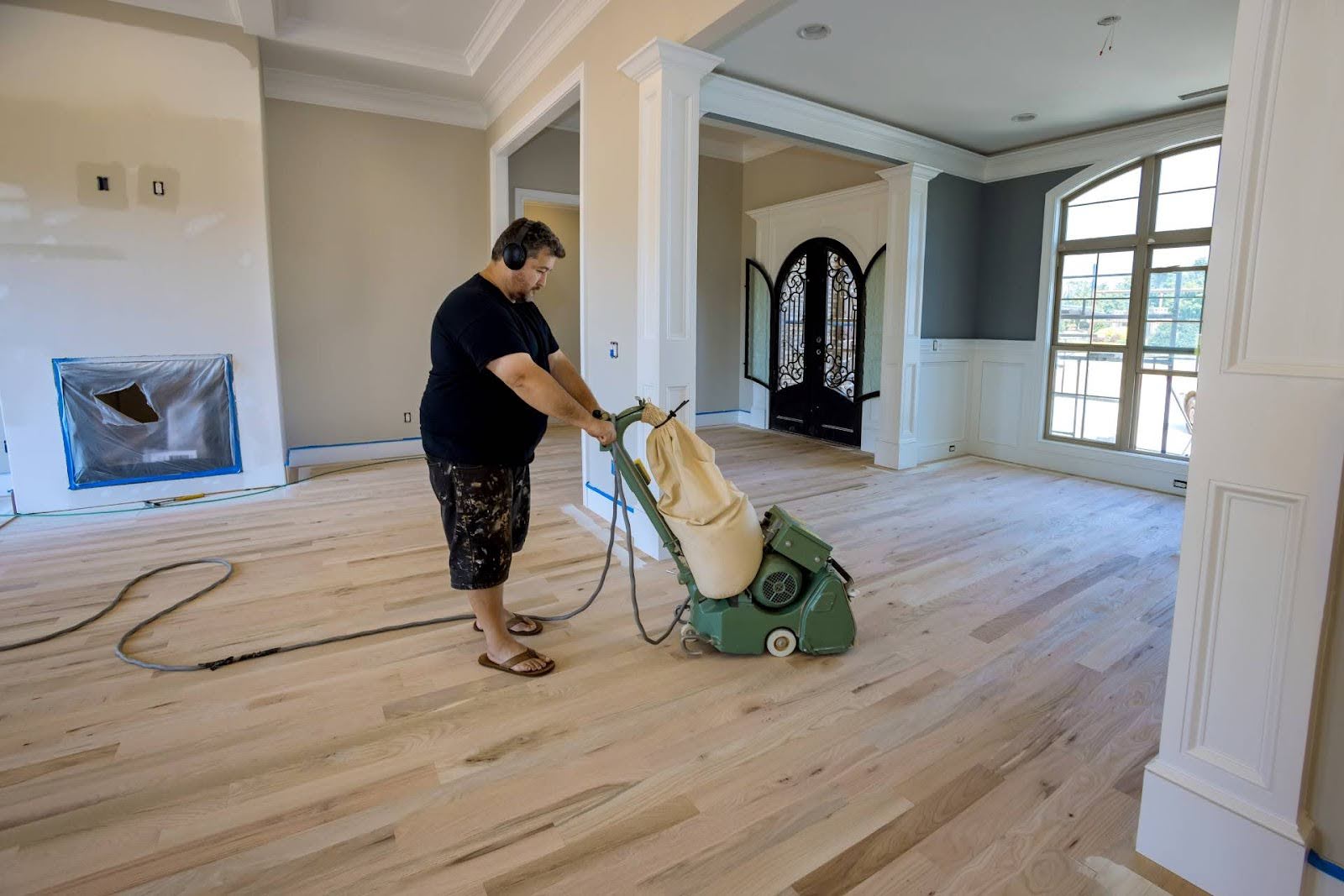Over time, your floor shows signs of wear. A complete treatment (including sanding and varnishing) is necessary to restore its original beauty. Although this process requires time and effort, it extends the life of your floor by several years.
What is Hardwood Floor Sanding?
Floor sanding is an abrasive technique that involves rubbing your hardwood floor with pressurized sand. This method removes embedded dust, dirt, and varnish residues, thoroughly cleaning the floor. A floor typically undergoes about seven sandings in its lifetime.
Important Note: There is often confusion between sanding and airbrushing/hydro gumming. Although these processes share the goal of stripping surfaces, their applications differ. Sanding strips surfaces in buildings and heavy industry, while airbrushing/hydro gumming is intended for localized and controlled stripping, such as monument restoration or valuable furniture.

Is Sanding Necessary Before Varnishing?
To restore the shine to your floor, two techniques are possible:
Floor Refreshing: Apply a new layer of varnish on the existing finish. This method is simple, quick, and does not require sanding. However, it is only sufficient if the floor is not damaged and its effect is short-lived.
Sanding and Varnishing: This method requires sanding before varnishing. Although more demanding, it offers durable results (10 to 15 years), eliminates significant wear marks, and allows you to change the colour or gloss of the varnish.
Essentials for Perfect Sanding
To achieve perfect sanding, you need the know-how and the right tools.
Necessary Skills:
- Dexterity
- Delicacy
- Patience
Necessary Equipment:
- Floor sander
- Sandpaper (coarse, medium, and fine grit)
- Corner sander
- High-quality vacuum cleaner
- Dust mask
- Work gloves
- Hearing protection
- Safety glasses
- Paint scraper
Depending on the extent of the work, you may also need finishing nails, a hammer, wood chisels, knee pads, and a tape measure.
How to Sand Your Hardwood Floor
While you can sand the floor yourself, calling professionals to avoid mistakes and achieve optimal results is recommended.
Steps for Sanding:
- Preparation:
- Completely clear the area by moving the furniture.
- Make necessary repairs (replacing boards, re-nailing).
- Clean the floor to avoid embedding contaminants.
- Sanding Method:
- Use a floor sander with coarse-grit sandpaper and sand in the direction of the wood grain.
- Then, use medium or fine-grit sandpaper for finer sanding.
- For optimal results, call experienced professionals like us, pioneers in the field since 1925.
- Post-Sanding:
- Remove all debris and dust with a vacuum cleaner.
- Use a cotton cloth soaked in water or methyl hydrate to remove residues and open the wood pores.
- Varnish the floor once cleaned. If you want to apply a stain, do so before varnishing.
Varnishing Your Hardwood Floor
Varnishing is the final and crucial step in enhancing your floor. To avoid air bubbles or roller marks, follow a precise procedure and use the appropriate varnish. Call our Montreal, Laval, North Shore, and South Shore professionals to maximize success.
The Benefits of Eco-Friendly Sanding
More and more people opt for eco-friendly sanding methods that use environmentally friendly products and techniques. These methods reduce environmental impact and are less harmful to health, offering high-quality results.
How to Choose the Right Varnish for Your Floor
Choosing the varnish is crucial for achieving a durable and aesthetic finish. There are different types of varnish, such as water- and oil-based varnishes, each with advantages. A water-based varnish dries faster and emits less odour, while an oil-based varnish offers more robust protection and a richer appearance.
Maintenance Frequency After Varnishing
A regular maintenance schedule is recommended to maintain the appearance and durability of your varnished floor. Vacuum or sweep frequently to remove dust and abrasive particles, and clean with a suitable product at least once a month. Annual maintenance by professionals can also extend the life of your varnish.
Conclusion
A beautiful floor contributes to your home’s identity. To keep your hardwood floors impeccable and welcoming, choose the eco-friendly and economical solution of sanding and varnishing. Contact our Montreal, Laval, North Shore, and South Shore professionals to benefit from quality service.
FAQ
Sanding a floor 100% dust-free is clearly utopian. However, it is possible to control 90% to 95% of the dust particles emitted during the operation. To achieve this, it is important to have the necessary tools and to follow a standard process. Only professionals are qualified to perform this task. If this is important to you, ask your professional if they offer this option.
If you want to strip your floor, then you will need either coarse or medium grit sandpaper. This will depend on how rough your floor is.
If on the other hand, you want to polish the floor, it is better to use fine grit sandpaper.
To remove varnish, it is common to use 36, 40, 50, 60, or 80-grit sandpaper.


